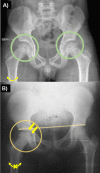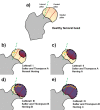Legg-Calvé-Perthes disease overview
- PMID: 35292045
- PMCID: PMC8922924
- DOI: 10.1186/s13023-022-02275-z
Legg-Calvé-Perthes disease overview
Abstract
Background: Legg-Calvé-Perthes Disease (LCPD) is a necrosis of the femoral head which affects the range of motion of the hips. Its incidence is variable, ranging from 0.4/100,000 to 29.0/ 100,000 children. Although LCPD was first described in the beginning of the past century, limited is known about its etiology. Our objective is to describe the main areas of interest in Legg-Calve-Perthes disease.
Methods: A review of the literature regarding LCPD etiology was performed, considering the following inclusion criteria: Studies reporting clinical or preclinical results. The research group carried out a filtered search on the PubMed and Science Direct databases. To maximize the suitability of the search results, we combined the terms ''Perthes disease" OR "LCPD" OR "children avascular femoral head necrosis" with "diagnostic" OR "treatment" OR "etiology" as either key words or MeSH terms.
Results: In this article been described some areas of interest in LCPD, we include topics such as: history, incidence, pathogenesis, diagnosis, treatment and possible etiology, since LCPD has an unknown etiology.
Conclusions: This review suggests that LCPD has a multifactorial etiology where environmental, metabolic and genetic agents could be involved.
Keywords: Biochemical factors; Diagnosis; Environmental factors; Genetic factors; LCPD; Treatment.
© 2022. The Author(s).
Conflict of interest statement
The authors declare that they have no competing interests.
Figures





Similar articles
-
Aetiology of Legg-Calvé-Perthes disease: A systematic review.World J Orthop. 2019 Mar 18;10(3):145-165. doi: 10.5312/wjo.v10.i3.145. eCollection 2019 Mar 18. World J Orthop. 2019. PMID: 30918798 Free PMC article.
-
[The possible origin of Legg-Calvé-Perthes disease].Rev Med Inst Mex Seguro Soc. 2019 Apr 1;57(1):36-41. Rev Med Inst Mex Seguro Soc. 2019. PMID: 31071253 Spanish.
-
Generation and characterization of mesenchymal stem cells from the affected femoral heads of dogs with Legg Calvé Perthes disease.Open Vet J. 2024 May;14(5):1172-1181. doi: 10.5455/OVJ.2024.v14.i5.12. Epub 2024 May 31. Open Vet J. 2024. PMID: 38938425 Free PMC article.
-
[Legg-Calvé-Perthes disease].Radiologie (Heidelb). 2023 Oct;63(10):736-744. doi: 10.1007/s00117-023-01182-z. Epub 2023 Jul 8. Radiologie (Heidelb). 2023. PMID: 37422572 Review. German.
-
Salter osteotomy in Legg-Calvé-Perthes disease.J Pediatr Orthop. 2011 Sep;31(2 Suppl):S192-7. doi: 10.1097/BPO.0b013e318223b59d. J Pediatr Orthop. 2011. PMID: 21857438 Review.
Cited by
-
Magnetic resonance-enhanced high-resolution three-dimensional water-selective cartilage sequence visualization of hip vessels in children.Int Orthop. 2024 Jun;48(6):1391-1399. doi: 10.1007/s00264-023-05883-x. Epub 2023 Jul 14. Int Orthop. 2024. PMID: 37442823
-
Clinical Image: Avascular necrosis of the femoral head driven by the COL2A1 gene mutation.ACR Open Rheumatol. 2025 Jan;7(1):e11762. doi: 10.1002/acr2.11762. Epub 2024 Oct 19. ACR Open Rheumatol. 2025. PMID: 39425611 Free PMC article. No abstract available.
-
Network Analysis of Legg-Calve-Perthes Disease and Its Comorbidities.J Clin Med. 2025 Jan 5;14(1):259. doi: 10.3390/jcm14010259. J Clin Med. 2025. PMID: 39797341 Free PMC article.
-
Total hip arthroplasty through the direct anterior approach for sequelae of Legg-Calvé-Perthes disease.Arch Orthop Trauma Surg. 2023 Sep;143(9):5935-5944. doi: 10.1007/s00402-023-04791-4. Epub 2023 Feb 18. Arch Orthop Trauma Surg. 2023. PMID: 36806985 Free PMC article.
-
The Availability and Readability of Multilingual Online Patient Materials for Legg-Calve-Perthes Disease.J Pediatr Soc North Am. 2025 Mar 6;11:100169. doi: 10.1016/j.jposna.2025.100169. eCollection 2025 May. J Pediatr Soc North Am. 2025. PMID: 40432851 Free PMC article.
References
-
- Padilla-Santamaría F, Maya-Franco L, Bolaños-Méndez GZ, Guerrero-Gómez DA. The possible origin of Legg–Calvé–Perthes disease. Rev Med Inst Mex Seguro Soc. 2019;57(1):36–41. - PubMed
-
- Manzon VS, Ferrante Z, Giganti M, Gualdi-Russo E. On the antiquity of Legg–Calvé–Perthes disease: skeletal evidence in iron age Italy. Homo. 2017;68(1):10–17. - PubMed
Publication types
MeSH terms
LinkOut - more resources
Full Text Sources
Other Literature Sources
Medical
Miscellaneous

